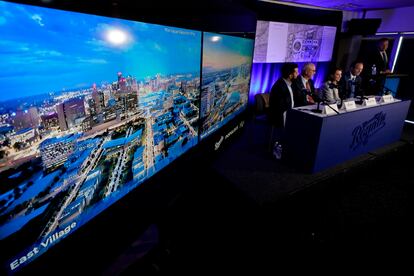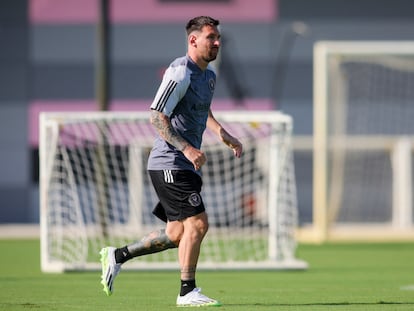Royals unveil proposed ballpark and entertainment district plans for 2 locations
The first location, called the East Village, would consist of a ballpark anchoring a 27-acre development just blocks away from the thriving Power & Light District

The Kansas City Royals unveiled plans for two dramatically different locations for a replacement to the aging Kauffman Stadium on Tuesday, calling them on equal footing even as the team-issued date for a decision looms next month.
The first location, called the East Village, would consist of a ballpark anchoring a 27-acre development just blocks away from the thriving Power & Light District, where T-Mobile Center already exists. The second location is a 90-acre tract across the Missouri River in Clay County, where the Royals would have more ability to develop commercial and residential properties.
Both plans were produced by Populous, the Kansas City-based sports architecture giant, which has been responsible for renovation or construction of more than 20 stadiums currently in use across Major League Baseball.
“We knew we were engaged in a generational decision. The K has been the home to the Royals for 50-plus years — been a great home — but it’s time for a new one,” said Brooks Sherman, the Royals’ president of business operations. “It’s actually incredible that we have these two locations to even consider as a future home and sustain ourselves as a Major League city.”
The Royals announced plans to leave Kauffman Stadium about two years ago. But progress has been slow in deciding on a path forward, given the myriad factors involved in the proposed $2 billion-plus ballpark and entertainment district.
The Royals have long shared with the Kansas City Chiefs sales tax revenue from Jackson County for the upkeep of Kauffman and Arrowhead stadiums, both of which reside in the Truman Sports Complex. But while the Royals intend to build elsewhere, the preference of Chiefs owner Clark Hunt is to remain at Arrowhead Stadium and renovate the existing NFL venue.
Further complicating matters is the fact that the Royals and Chiefs are both tied to a lease with Jackson County that does not expire until 2031. If the Royals decide on the downtown location, they would remain in Jackson County and the teams could seek to extend the lease; if they move to Clay County, some tricky politicking and negotiation would be necessary.
Regardless of the site, Sherman reiterated that the Royals are prepared to spend about $1 billion in private funds on the project, and they intend to move into their new stadium for opening day of the 2028 season.
“That’s part of the equation is to ensure we’re negotiating properly and having the proper back and forth with each set of governing bodies — the elected leaders — and we’re doing that with both Clay County and Jackson County,” Sherman said.
The downtown site, which has long been viewed as the frontrunner, would lean into commercial and business possibilities to help drive the revenue that MLB Commissioner Rob Manfred has said is necessary for a small-market club to compete.
The proposed stadium, which Populous founder Earl Santee warned is not a final design, features swooping roof lines that are reminiscent of Kauffman Stadium. There is a homage to the fountains for which the existing park is known in right-center field and what Santee called “one of the most intimate seating bowls in all of baseball.”
Yet the stadium comes with drawbacks. Ingress and egress is already a challenge in the downtown corridor, and parking could be difficult, particularly for day games when existing parking is already taken up by those working in the area.
The location in North Kansas City would continue the revitalization of what was once a rundown industrial neighborhood.
The ballpark is meant to feel more “gritty,” Santee said, to better fit within the existing area. But a large number of buildings would be razed to make room for hotels and conference centers, residential buildings and parking pavilions, and a large park and lake that could serve as a year-round gathering space. There is even a proposed 4,000-seat performance venue.
Imran Aukhil with the economic advisory firm HR&A said both projects would have about a $320 million impact on the region, not including the construction itself, which would spur at least 20,000 jobs and $2.8 billion in total economic output.
As the late-September date for a decision nears, the Royals are continuing to negotiate with political and business leaders involved with both proposed locations. They also are soliciting feedback from fans, many of whom have been lukewarm about the prospect of building a new ballpark for a team that is once again on pace to lose more than 100 games.
“We’ve got work to do on a number of fronts,” Sherman said, “to get to our decision on this.”
Sign up for our weekly newsletter to get more English-language news coverage from EL PAÍS USA Edition
Tu suscripción se está usando en otro dispositivo
¿Quieres añadir otro usuario a tu suscripción?
Si continúas leyendo en este dispositivo, no se podrá leer en el otro.
FlechaTu suscripción se está usando en otro dispositivo y solo puedes acceder a EL PAÍS desde un dispositivo a la vez.
Si quieres compartir tu cuenta, cambia tu suscripción a la modalidad Premium, así podrás añadir otro usuario. Cada uno accederá con su propia cuenta de email, lo que os permitirá personalizar vuestra experiencia en EL PAÍS.
¿Tienes una suscripción de empresa? Accede aquí para contratar más cuentas.
En el caso de no saber quién está usando tu cuenta, te recomendamos cambiar tu contraseña aquí.
Si decides continuar compartiendo tu cuenta, este mensaje se mostrará en tu dispositivo y en el de la otra persona que está usando tu cuenta de forma indefinida, afectando a tu experiencia de lectura. Puedes consultar aquí los términos y condiciones de la suscripción digital.
More information
Archived In
Últimas noticias
Most viewed
- Oona Chaplin: ‘I told James Cameron that I was living in a treehouse and starting a permaculture project with a friend’
- Reinhard Genzel, Nobel laureate in physics: ‘One-minute videos will never give you the truth’
- Sinaloa Cartel war is taking its toll on Los Chapitos
- Why the price of coffee has skyrocketed: from Brazilian plantations to specialty coffee houses
- Silver prices are going crazy: This is what’s fueling the rally










































